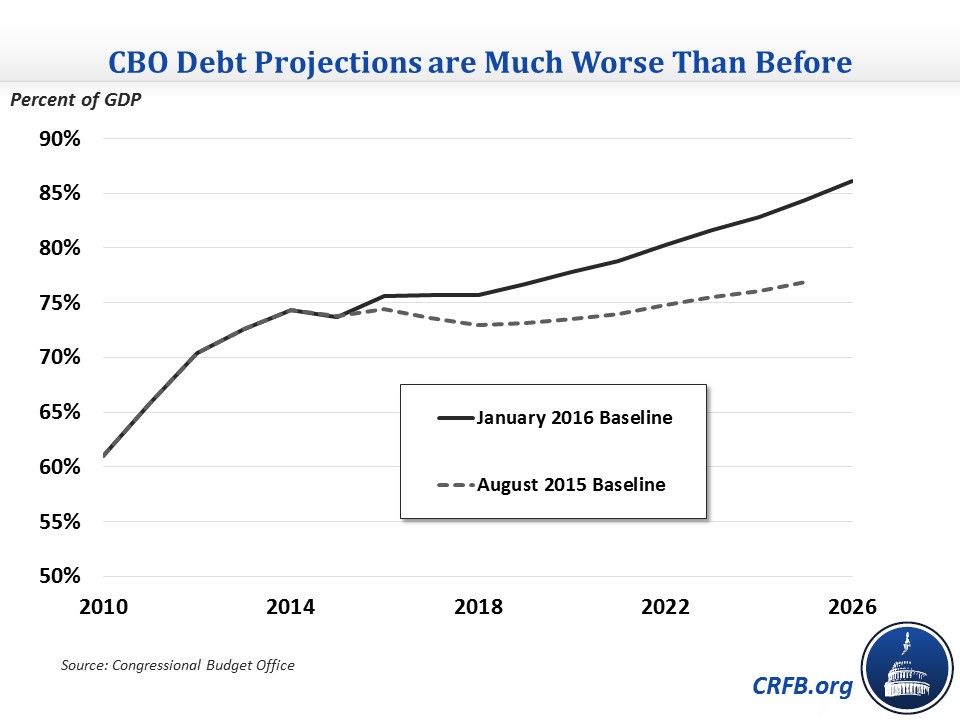Deficits Rise in Latest Budget Projections
Update: You can view our full analysis here.
The Congressional Budget Office (CBO) just released baseline projections showing rapidly rising deficits and debt rising in the coming years – at a much faster pace than previously projected. CRFB will release a full analysis later today, but the report makes it abundantly clear that the near record-high national debt is on an unsustainable path.
CBO now projects deficits more than tripling, from $439 billion in 2015 to $1.37 trillion by 2026, with trillion dollar deficits returning by 2022 – three years earlier than prior projections.
Debt held by the public, meanwhile, will grow by over $10 trillion from $13.1 trillion at the end of 2015 to $23.8 trillion by 2026. As a share of Gross Domestic Product (GDP), debt will grow from 74 percent of GDP in 2015 – already twice its pre-recession levels – to 86 percent of GDP in 2026. By comparison, August projections showed debt on track to reach roughly 77 percent of GDP, or $21 trillion, by 2025.

Driving higher debt projections is a mixture of lower economic growth projections and significantly higher deficits resulting from fiscally irresponsible legislation enacted last year. This is particularly true for the 2016 deficit, which had been projected to remain roughly flat at the 2015 level but is now projected to grow by one-quarter – from $439 billion to $544 billion – mainly because of the tax extenders and omnibus spending bill passed at the end of last year.
Over ten years, deficits are over $1.5 trillion higher than projected in August between 2016 and 2025, and about $2.4 trillion – or 33 percent worse, when comparing the new ten year window to the old one. The largest driver of this difference is legislation changes, especially the $855 billion tax extenders and omnibus spending package. Total legislative changes appear somewhat lower, driven by gimmicks and baseline quirks surrounding the $70 billion highway bill and the Bipartisan Budget Act. The remaining difference is from a combination of economic and technical factors, especially driven by lower projected economic growth.
| Change in CBO's Baseline Budget Projections | |
| From August | |
| Prior Baseline Projections (2016-2025) | $7.007 trillion |
| Tax Extenders and Omnibus Package* | $855 billion |
| Other Legislation (Mostly Gimmicks)* | -$100 billion |
| Economic Changes | $435 billion |
| Technical Changes | $365 billion |
| Jan 2016 Baseline Projections (2016-2025) | $8.556 trillion |
| Change in Budget Window | $820 billion |
| Jan 2016 Baseline Projections (2017-2026) | $9.378 trillion |
| Change in Baseline Deficits (2016-2025) | $1.547 trillion |
| Change in Baseline Deficits (Old to New Budget Window) | $2.371 trillion |
Source: CBO, CRFB calculations
Note: Changes are rounded to the nearest $5 billion. Numbers may not add up due to rounding. All numbers include debt service.
*CRFB estimates based on CBO data.
CBO shows a worse debt picture than before both because of lawmakers' own doing and other factors. It is clear now that deficits will no longer be in decline as they have been for the past five years, and debt will continue to increase from near-record high levels. The complacency that lawmakers have shown about debt over the past few years must end so they can address the troublesome trajectory of deficits and debt.
Check our website later today for more complete analysis of CBO's new report.


